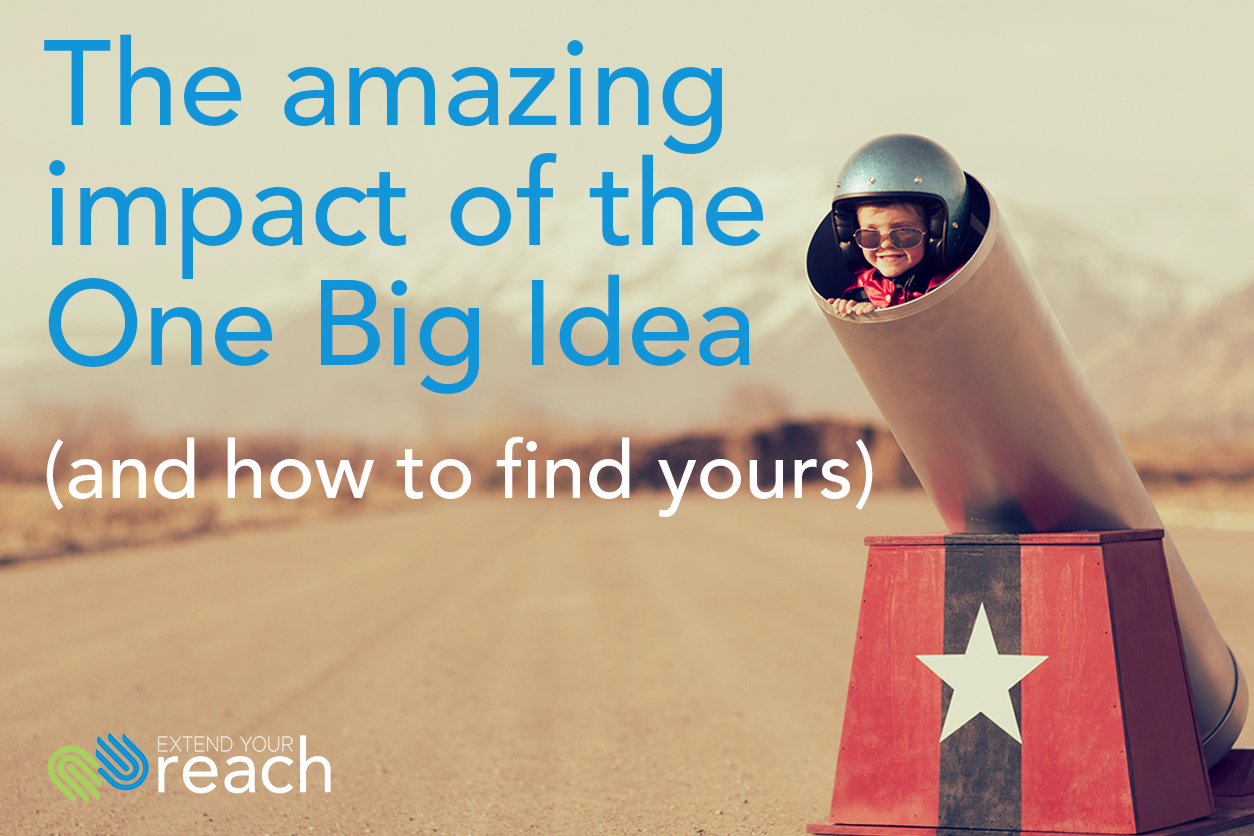By: Kim Farrow
Let’s talk about big ideas.
No, I don’t mean that invention you came up with in seventh grade but haven’t ever gotten around to actually inventing.
I’m talking about your company’s ONE BIG IDEA.

What is the Big Idea?
Our version of the “One Big Idea” is a concept based on a concept. The first originated from David Ogilvy, who is known as the Father of Advertising. In his book, On Advertising, Ogilvy wrote:
“You can do homework from now until doomsday, but you will never win fame and fortune unless you also invent big ideas… It takes a big idea to attract the attention of consumers and get them to buy your product… and no idea is big unless it will work for thirty years”
Instead of putting the pressure on ourselves to find big ideas that will last 30 years as Ogilvy suggests, though, I believe they can be much simpler.
When we say “One Big Idea” at Reach, what we’re talking about is the single, central message that drives all of your marketing pieces – it could be for the life of the product or, at the very least, for the duration of a campaign. Some people call it a value proposition. Others call it competitive advantage. Adopted long term, it can turn into full-on brand positioning.
Whatever you call it, your One Big Idea is the key to helping your audience understand the value your brand, organization, products, or services can bring to them. It can be creative or straightforward, but it needs to clearly convey:
- Why what you’re offering is important in the first place
- How what you offer is different (read: better) than any other business with a similar product or service offering
Now that you get what the One Big Idea is meant to do, it’s important to mention: Every business should have one.
Why you need a Big Idea
The One Big Idea can take things that are at risk of becoming (or already are) a commodity, and turn them into specialized products or services that people are willing to pay for – because of the specific benefit they bring.
Let’s look at how this applies to, say… cookies. (It’s a topic I’m quite familiar with.)
 I’ve recently started seeing ads all over Facebook and Instagram for FlapJacked baking mixes, particularly their cookie mix.
I’ve recently started seeing ads all over Facebook and Instagram for FlapJacked baking mixes, particularly their cookie mix.
This isn’t just any kind of cookie mix – it’s protein-packed, natural-ingredient-filled, good-for-you cookie mix. It sounds perfect for any sweet-toothed, self-control-lacking lady like me, whose metabolism is slowing down as I type.
FlapJacked doesn’t just sell cookie mix, either. They also sell muffin mix and pancake mix – all made with natural, healthier ingredients, and all packed with protein.
If you’re wondering, how does this all relate to the One Big Idea again? – here’s the connection:
FlapJacked’s products – and, as a result, their marketing messages – are based on the company’s One Big Idea: Giving health-conscious people baked goods that actually provide nutrition, and won’t leave them feeling guilty after they indulge.
There are hundreds of brands that sell baking mixes, but FlapJacked found a way to stand out by creating a better-for-you version. And they’re marketing them to the right audience, using a consistent message to get the word out. That’s the One Big Idea in action.
When you’re creating a marketing plan or campaign, your One Big Idea should drive the message for each piece. If your Big Idea is providing customers with convenience, all your headlines, body copy, taglines, and graphics should work toward that message. It doesn’t have to be in-your-face explicitly stated, but your audience must be able to make the connection.
So how can you find your One Big Idea?
Ultimately, your One Big Idea should be driven by the value and the benefits you can provide to your audience. If you sell a variety of products or services, this can be done on a product-by-product basis – but keep in mind that any Big Ideas about your products should be tied back to your company’s brand as a whole.
With this in mind, here are three tips to help you determine your own Big Idea(s):
1. Get to the heart of what you do.
Like FlapJacked, your organization was likely founded for one of the following reasons:
- To solve a problem for which no other business had a solution
- To improve an already existing solution or fill a gap in the industry
- To make money… by solving a problem or filling a gap
Understanding the reason behind your organization’s founding is a great way to start getting to the core of your One Big Idea. Similarly, if your organization has changed over time (like us), it can be helpful to dig down and find the reasoning behind your evolution.

A quick way to do this is to reframe the question of “what do we do for our customers?” Instead, ask: What do we help our customers accomplish?
At Reach, we offer marketing services. But digging deeper, we offer complete marketing services under one roof to help our customers build their businesses without the stress of managing multiple campaigns and vendors on their own.
Make sense? By really getting to the heart of what you do, you can start to identify what sets you apart, which leads perfectly into the next tip…
2. Figure out what you do really well – and what you don’t.
If you truly want to know what sets you apart, take the time to assess your strengths and weaknesses by talking to leadership, employees, and even long-term customers. Then, create a SWOT analysis with the feedback you gather from various interested parties.

The SWOT analysis will help you identify your One Big Idea by helping you figure out what you do best for your customers. At the same time, identifying weaknesses will help you narrow your focus.
For example, think of a company that provides software as a service. The company may have an excellent customer service team, even if their software maybe lacks a useful, but not critical feature that other similar companies provide. Instead of centering their marketing campaigns around being cutting-edge, this company should instead highlight how they make customers lives easier by quickly and effectively responding to support requests and concerns.
This idea can stand for individual products or services, too. As you’re planning a marketing campaign for a specific product, consider using the SWOT analysis to find ways that your product will really benefit customers, as well as the shortcomings it may have – this will help make sure your message is consistent with the experience your product delivers.
You don’t necessarily have to point out the weaknesses, but you certainly don’t want to highlight them as a Big Idea in your marketing efforts.
3. Don’t try to be all things to everyone.
As you find your One Big Idea, it’s important not to give in to the fear of potentially alienating a specific group. In fact, the point of having One Big Idea is to separate yourself from the competition, which may also mean separating yourself from prospective customers who don’t share the same priorities as you.
Think of it this way: If you do an okay job serving everyone, you won’t ever do a great job serving anyone. In other words, if you try to be all things to all people, your message will end up diluted.
As a result, your brand, products, and services won’t inspire any kind of passion. That passion is necessary to gain the trust of prospects, keep customers happy, and ultimately gain referrals from a loyal customer base.
 Here’s an example: Oiselle is a brand that creates and sells running apparel for women – and only women. Their One Big Idea is to create a sisterhood of empowered women who feel good in the clothes they run in. If Oiselle were to start selling men’s running clothes, it would undermine their Big Idea entirely. Sure, they’re missing out on a huge section of the running market, but their passionate fan base is enough to keep them in business – a fan base which, by the way, is willing to pay more for the experience they get from buying Oiselle clothing.
Here’s an example: Oiselle is a brand that creates and sells running apparel for women – and only women. Their One Big Idea is to create a sisterhood of empowered women who feel good in the clothes they run in. If Oiselle were to start selling men’s running clothes, it would undermine their Big Idea entirely. Sure, they’re missing out on a huge section of the running market, but their passionate fan base is enough to keep them in business – a fan base which, by the way, is willing to pay more for the experience they get from buying Oiselle clothing.
Now think about how you relate to your own customer base. Is it possible that your message diluted? Can you center in on serving a specific group, instead of trying to appeal to the masses?
Time to get to work.
Complete transparency here: Coming up with your One Big Idea is going to be tough, especially if you plan to use that idea for years to come.
And enforcing that One Big Idea will be tough, too. You’ll likely be faced with the challenge of saying “no” to some really creative ideas, just because they don’t fit in with your One Big Idea.
Remember, the point of the Big Idea is not to limit your business or brand in any way – instead, the goal is to find a focus, deliver a consistent message, and get to a point where people know you for what you do. Then, you can take on the world.
Happy strategizing!














